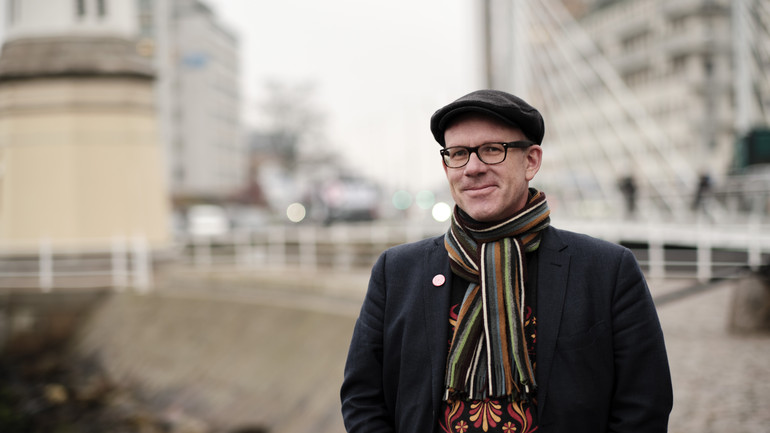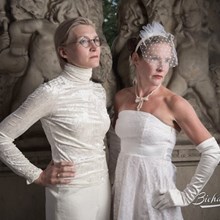Fiction Addiction
About "Fiction Addiction"
Fiction has a unique ability to transcend boundaries. Reading takes us to times we’ve never lived in and places we’ve never visited. It develops our language, our empathy, and gives us words for feelings we didn’t yet know we had. It builds bridges between people.
More than half of Swedes (aged 9–85) read or listen to a book on an average day, according to a survey 2024 by the Media Barometer at the University of Gothenburg. This is the highest number since measurements began in the late 1970s. Recreational reading can inspire book clubs, theatre, music, and literary travel—or take on a physical form through live-action role-playing (LARP).
In the exhibition Fiction Addiction, you can explore research rooted in literature and reading.
The exhibition is part of the Researchers’ Gallery at Malmö University Library and is created in collaboration with researchers Sara Bjärstorp and Petra Ragnerstam from the Faculty of Culture and Society, and Magnus Persson from the Faculty of Education and Society.
The exhibition will be on display from May 2025 to April 2026.

Passionate Reading
Magnus Persson, Professor of Literature with a focus on Didactics, Faculty of Education and Society. Reading is in decline. We are in the midst of a reading crisis of enormous proportions. Children and young people have stopped reading books. University students can no longer engage with longer...

Passionate Reading
Magnus Persson, Professor of Literature with a focus on Didactics, Faculty of Education and Society. Reading is in decline. We are in the midst of a reading crisis of enormous proportions. Children and young people have stopped reading books. University students can no longer engage with longer texts. Do these arguments sound familiar?
Whatever the reality of the situation, the fact remains that there are still many passionate readers—people who love literature and cannot imagine a life without books. Why does no one talk about them? What actually characterises passionate reading and a love of literature? In my research, I approach passionate reading from theoretical, practical, and didactic perspectives, as there is, surprisingly, very little research on the subject.
Passionate readers can be found everywhere—if you know where to look. Some make it their profession: teachers, librarians, literary scholars, critics. But there are also countless ordinary readers who read alone at home in an armchair or in bed, yet who also enjoy sharing their interest in literature with other passionate readers—at literary festivals, in private book clubs, on trips, and across a multitude of online forums.
What does it actually mean to be a passionate reader? What similarities and differences exist between professional and ordinary readers? What role does place play in the reading experience? Which surrounding factors influence reading—objects, people, other media, and art forms? What role do the body and emotions play? In research, such questions have often been neglected—or, worse, dismissed as irrelevant. I use a single concept to bring together all these factors and phenomena: peripheral reading (omkringläsning). And it turns out that these elements are absolutely central to every reading experience!

Literary Live Action Role-Play (LARP)
Sara Bjärstorp and Petra Ragnerstam, PhD in English with a focus on Literary Studies, Faculty of Culture and Society.

Literary Live Action Role-Play (LARP)
Sara Bjärstorp and Petra Ragnerstam, PhD in English with a focus on Literary Studies, Faculty of Culture and Society.
Today, fiction is increasingly disseminated through a variety of media, engaging far more people than traditional readers alone. Research on literature’s different forms of expression has often focused on intermediality, while aspects such as embodiment, participation, and interactive modes of creation have received less attention.
In our research, we study live-action-role-playing (LARP) based on literary works such as Hamlet, Miss Julie, A Doll’s House, and the novels of Jane Austen. We explore questions such as: What happens when a literary narrative is transformed into a LARP? How can we understand the story that is created—both individually and collectively—and which narrative techniques are used? What does it feel like to embody characters and events from literature? How do participants engage with social norms, and how are those norms challenged within the LARP?
Using these questions as a starting point, we aim to understand how new literary practices are transforming the reading experience. These questions also provide an entry point into broader issues of participation and co-creation, which are fundamental to LARP but also central to contemporary culture.
Films in the exhibition
Follow in Your Favourite Author’s Footsteps
Follow in Your Favourite Author’s Footsteps
“Since at least the Romantic era, devoted readers have sought out meaningful places connected to a beloved author’s life, or searched for the real-world locations of fictional settings described in their books. There are many signs that this phenomenon is currently experiencing a strong resurgence (see Sjöholm 2011), with Harry Potter tourism perhaps being the most well-known example.” —from the book "Passionerad läsning" by Magnus Persson, p. 189 [our translation]
Book Fairs and Literary Festivals
Book Fairs and Literary Festivals
“Literary festivals are an increasingly widespread and popular phenomenon. They may, for example, focus on regional literature or world literature, a single author or a particular genre, literature in general or a specific theme.” —from the book "Passion för fiktion" by Magnus Persson, p. 73 [our translation]
Films from the exhibition
Dance from the LARP "Fortune and Felicity"
Dance from the LARP "Fortune and Felicity"
https://www.youtube.com/embed/Uzf3Aobnycs?enablejsapi=1&rel=0&showinfo=1&controls=1